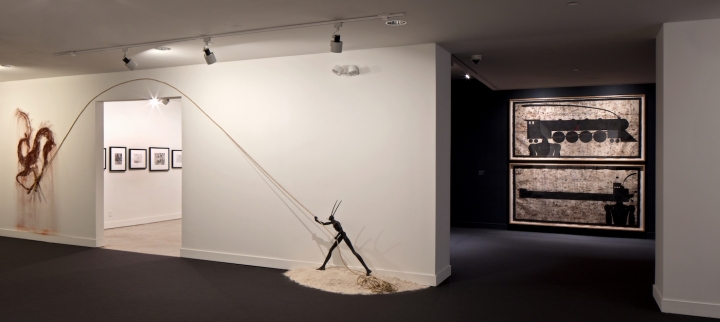
A review by Monica Uszerowicz for Hyperallergic.
In the Yoruban tradition, Ogun — or Ògún, Oggun, or Ogum — is the orisha (spirit) of metals, a powerful warrior often depicted brandishing a sword he forged himself. He is the deity for hunters, drivers, and blacksmiths, and while he is not quite a gatekeeper, nor a figure who stands at the crossroads between the human and spirit realms, Ogun is said to be the first orisha to come to earth, searching for a space for humans to inhabit, using a metal instrument to clear the path for other orishas.
There is something distinctly human — even humanitarian — in the mythos of Ogun, an orisha of work and workers and earthly materials. Coincidentally, many African slaves were brought to Cuba specifically to work as blacksmiths, building a railroad system. Ogun might have been their orisha, watching over them. He features prominently in José Bedia Fieldwork: Selections from the de la Cruz Collection and the Artist, an exhibition now on view at the NSU Art Museum Fort Lauderdale. Fieldwork showcases the unique space Bedia occupies: the Cuban artist is, concurrently and synergistically, artist and anthropologist, spiritual cosmologist and religious practitioner.

An integral part of Cuba’s “Generation of the ’80s”— a group of young artists whose work addressed a spiritual language specific to the nation — Bedia was initiated into the Regla de Congo or Palo tradition, a multi-denominational religion that developed among Central African slaves brought to Cuba. While Fieldwork features Bedia’s collection of African traditional art — amassed while traveling with curator and anthropologist Manuel Jordán — there are also his own pieces, side-by-side, creating a kind of retrospective that showcases both his anthropological and deeply personal interest in the rituals and traditions depicted here. The exhibition includes over 45 drawings from five sketchbooks, on view for the first time, drawn over ten years as Bedia traveled through Zambia, Kenya, and Botswana.
And there is Ogun. On loan from the de la Cruz collection, the Ogun series is comprised of massive ink-and-acrylic works on paper, displaying Ogun forging his machete, and then — in several other pieces — becoming the industrial objects he symbolically assists in creating. In one image, his head is the front of an airplane; in another, it is the bow of a ship; in still another, his entire head is a helicopter. Ogun is protector of all of these — transportation machine and tool alike — though he also animates the hands that created them, the bodies that ultimately imbue them with their physical and spiritual value.

Bedia first went to Africa in 1984 as part of the Cuban army’s artistic brigade, and he stayed in Angola. After quitting the brigade, Bedia joined the military caravans that supplied military units to that country. He’d travel throughout the continent over the next several decades, spending time in Botsanwa, Kenya, Tanzania, Egypt, South Africa, and the aforementioned Zambia, sometimes with Jordán — all the while accumulating, it seems, a deeper understanding of his own spiritual history.
The links between Bedia’s Cuban heritage and its ancestral roots in West and Central Africa is revered in Fieldwork: drawings by Zambian artist Benfrey Chitofu (commissioned by Bedia) of the rituals of the Lunda people; drawings of symbols by Maliya Chitofu, Benfrey’s mother; a video featuring Makishi mask traditions and dances amongst the Lunda; a Makishi mask built by another Chitofu family artist, Charles; and, framing a doorway, a massive piece by Bedia featuring Nkuyo Nfinda, a deity in the Monte branch of the Palo religion. In Bedia’s “Nkuyo Nfinda Hunting” (2017), an onyx-colored figure stands on one side of the exhibition’s entrance, holding a rope that stretches over the archway to the other side, where it grasps the hooves of a donkey made of sand and reddish tukula powder. Many of the larger works on paper contain silhouettes of animals that seem both human and animal, orisha and man; here, they come to life.
The sketchbooks Bedia filled while traveling also document religious practices he found throughout the continent, but the images — usually made with watercolor — are mostly of everyday moments: green landscapes, hippos in profile, women dancing, panthers drinking from ponds. Viewers are invited to check them out in vitrines, in frames, or on a scrolling screen. Though they’re clearly painted with a quick hand, they are soothing to look at. There’s an animism to most of the objects in Fieldwork, as if Bedia suffused them with either the practices of Palo or simply a veneration of his own ancestry. But even these watercolors, pale in tone and devoid of sacred symbolism, also feel somehow alive. They are, in effect, part of a kind of cosmology Bedia has created himself: one that fuses history, religion, and mythos, a past he revives by the act of living it.
José Bedia Fieldwork: Selections from the de la Cruz Collection and the Artistcontinues through October 8 at the NSU Art Museum Fort Lauderdale at Nova Southeastern University(1 East Las Olas Boulevard, Fort Lauderdale, FL).
